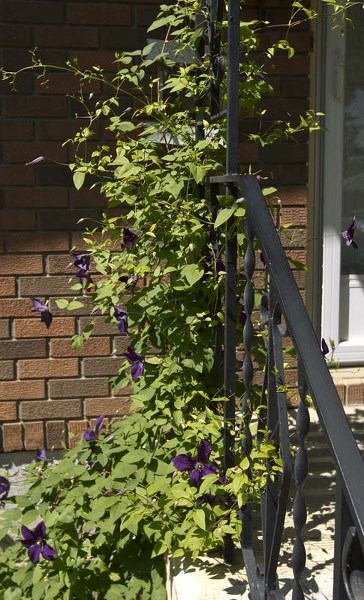It’s easy to get a little bored with the garden by mid-July. Yes, the petunias need watering – again! The tomatoes need staking. And pruning! Again! The same flowers that were in your yard yesterday are there again today and need the same TLC. But if you have a yearning to play with your plants, you need a vine. Vining plants have personality!
One of the wildest, free-growing vines available is the hops plant. Without fertilizer or even a drop of water other than what falls from the sky, a hops will do just as its name suggests and hop 20 or 30 feet as its tendrils grasp onto every available trellis or tree. If there is nothing to climb, an established hops will crawl along the ground.
“They fill an area that’s for sure. Alpine clematis is the same and reaches the same height – so high it provides shade,” said Jim Hole, co-owner of Hole’s Greenhouses and Gardens.
The fun part of the hops comes when you try to train the thing to climb in a different direction than the one it chooses. Hops vines, which are properly called “bines,” will always twine themselves in a counter-clockwise fashion and you cannot make them go the other way.
“They’ve done studies that show that over 90 per cent of all vines twist in a counter-clockwise way and it doesn’t matter where in the world they are growing. They could be in your backyard or in a different hemisphere and still they turn that way,” said Hole.
Hole believes the molecular structure of the plants is what makes them curve in a certain way.
“I think it’s the way the molecular bricks are put together and they are curved a certain way,” he said.
The very molecular structure of the plant is the reason vines need to climb and most don’t do well if they don’t have something to climb on. A morning glory in a pot without a trellis will seem dwarfed compared to one that’s allowed to climb.
“They must be stimulated to grow when they touch something they can climb up on,” Hole speculated.
Other perennial climbers that reach for the sky are Virginia creepers and scarlett trumpet honeysuckle.
“If you want height, think of the Virginia creeper. It turns orangy/red in the fall so it’s good for fall colour,” said Hole, adding that, unfortunately, there can be a downside to the creeper.
“They are the vines you see climbing up the buildings at the university. But Virginia creeper have little pads on their tendrils that allow them to climb up brick. They are nice on arbours, but if you don’t want them on your wall, they can be hard to pull down,” he said.
The many dozens of varieties of clematis make this perennial vine a colourful and popular cover for walls and fences, as long as it has a supporting trellis to climb on. On a long fence, between two yards for example, a variety of perennial clematis can make a stunning mid-summer show.
“The Jackman clematis is spectacular with big purple flowers and once they get established, they don’t need a lot of care,” Hole said.
Hardy varieties of grapes will grow 12 feet in a year and make an excellent arbour cover, Hole said.
“It depends what you want them for. If you want lots of grape production, you would prune them and cut them back because the more sun the leaves get, the more fruit you get. If you want them for a cover, let them go and they will almost go wild for you.”
If your garden is a back balcony, you can still grow vines. Some that do well in pots with a trellis support are scarlet runner beans, morning glories and black-eyed susan vines. The beauty of these plants is they can easily be grown quite inexpensively from seed.




